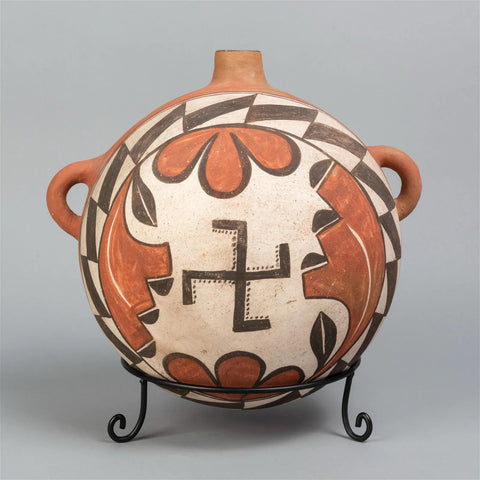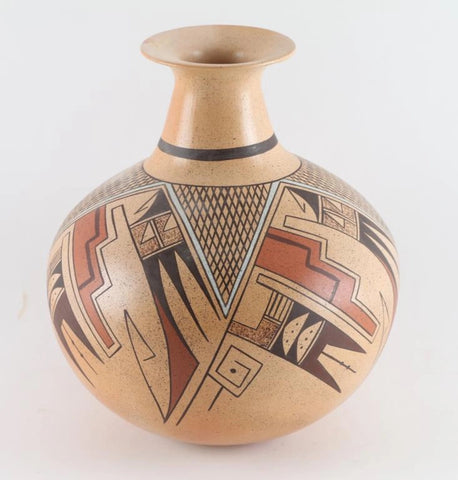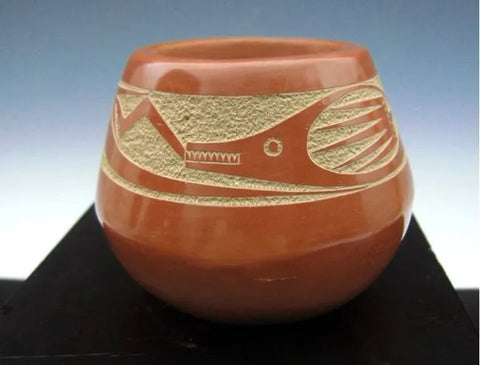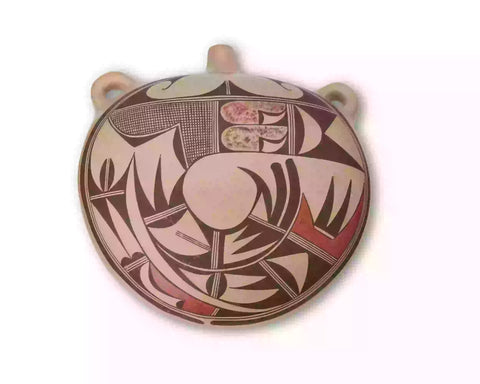
Native American Pottery : Very Rare Early Native American Tesuque Pottery #201
$ 4,800.00
Native American
Tesuque Pottery
201. Description: Native American Tesuque pottery with geometric frieze. White slip with black decoration. Small chip to rim and paint loss, hairline crack on bottom. 6 1/2" H x 6 3/4" dia.; 4 3/8" dia. of top. From the Estate of Charles P. Lamb.
An interesting article follows about the life and times of Charles P. Lamb that makes interesting reading about the man who collected this unique piece of pottery.
By BY LEONARD SPARKS
Times Herald-Record
Published: 9:25 PM - 05/30/14
LIVINGSTON MANOR: Charles Lamb called his need to create "my curse." He spent decades using his Livingston Manor property as a palette for his metal- and wood-crafting skills and a repository for hundreds of antique decorative-art and sculpture pieces he collected in obscurity.
But the spotlight Lamb avoided while alive is about to brightly light his life and artwork because of the efforts of Liberty attorney Brian Rourke, who Lamb asked to manage his estate before he died at 87 in January 2013.
Appraisers and workers assembled by New York City-based Roland Antiques are busy cataloging Lamb's metal and wood sculptures, his collection of Asian antiquities, sculptures and ceramics, and 12-foot-high castle doors dating from the 17th century.
Roland Antiques will ship over 400 pieces to New York for a June 14 auction to benefit Doctors Without Borders, Lamb's designated charity. The auction will also introduce the world to an artist who worked and collected in obscurity.
"This is real art," said Bill Roland, who says the collection is difficult to price but could bring between $100,000 and $250,000. "This guy was a genius."
A Lamb-sculpted dragon sits outside his property's main house. Along the property's creek is a series of brick arches he built, and the creek's waters spill over the dam he remade by hand, aided by a pulley system used to move stones.
Lamb was a Stanford-trained engineer and theater-arts major who fought in World War II, acted in and led the Dobbs Ferry Players.
He turned to furniture design, selling to clients that included jazz great Stan Getz. In 1972, he bought the Livingston Manor property.
There, the untrained sculptor and artist turned a barn into a studio where he began handcrafting metal figurines and decorative artworks, and wood carvings.
"I felt a connection to this gentleman and a desire to make sure that what he labored for, what he built, was not just forgotten after everything was sold," Rourke said
.
Among the handmade finds in his main house is a cabinet with a motorized door. There is a collection of China-made bowls dating from the 1500's and 1600's and an elephant-shaped Japanese urn from the 1800's.
A set of 16th- to 17th-century castle doors with hand-carved panels is fitted into one side of the building housing his workshop. The first and second floors of the workshop hold treasures such as a full-size knight figurine and a chess set whose figures take medieval legends as a model.
"Each piece is modeled individually," said Cynthia Pappas, an art expert working with Roland.
Roland estimates that he will auction about 500 pieces in total, including about 200 of Lamb's original pieces.
He expects to attract attention from dealers near his Greenwich Village gallery and through newspaper advertisements, and plans to send an email blast to about 200,000 names on an auctioneer's list.
"I think when the world sees this, they're going to go crazy," Roland said.
--------------------------------------------------------------------------------------------
A History of Pueblo Pottery:
Pueblo pottery is made using a coiled technique that came into northern Arizona and New Mexico from the south, some 1500 years ago. In the four-corners region of the US, nineteen pueblos and villages have historically produced pottery. Although each of these pueblos use similar traditional methods of coiling, shaping, finishing and firing, the pottery from each is distinctive. Various clay's gathered from each pueblo's local sources produce pottery colors that range from buff to earthy yellows, oranges, and reds, as well as black. Fired pots are sometimes left plain and other times decorated most frequently with paint and occasionally with applique. Painted designs vary from pueblo to pueblo, yet share an ancient iconography based on abstract representations of clouds, rain, feathers, birds, plants, animals and other natural world features.
Tempering materials and paints, also from natural sources, contribute further to the distinctiveness of each pueblo's pottery. Some paints are derived from plants, others from minerals. Before firing, potters in some pueblos apply a light colored slip to their pottery, which creates a bright background for painted designs or simply a lighter color plain ware vessel. Designs are painted on before firing, traditionally with a brush fashioned from yucca fiber.
Different combinations of paint color, clay color, and slips are characteristic of different pueblos. Among them are black on cream, black on buff, black on red, dark brown and dark red on white (as found in Zuni pottery), matte red on red, and poly chrome a number of natural colors on one vessel (most typically associated with Hopi). Pueblo potters also produce un-decorated polished black ware, black on black ware, and carved red and carved black wares.
Making pueblo pottery is a time-consuming effort that includes gathering and preparing the clay, building and shaping the coiled pot, gathering plants to make the colored dyes, constructing yucca brushes, and, often, making a clay slip. While some Pueblo artists fire in kilns, most still fire in the traditional way in an outside fire pit, covering their vessels with large potsherds and dried sheep dung. Pottery is left to bake for many hours, producing a high-fired result.
Today, Pueblo potters continue to honor this centuries-old tradition of hand-coiled pottery production, yet value the need for contemporary artistic expression as well. They continue to improve their style, methods and designs, often combining traditional and contemporary techniques to create striking new works of art. (Source: Museum of Northern Arizona)
----------------
View the other items in my shop: http://www.etsy.com/shop/CulturalPatina?ref=shopsection_shophome_leftnav




